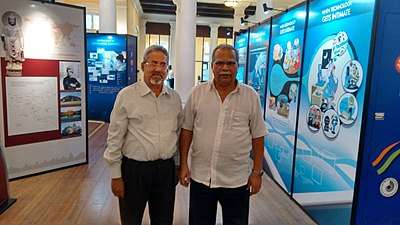Ramasamy Palanisamy
| Yang Berhormat Prof. Dr. Ramasamy Palanisamy இராமசாமி பழனிசாமி MLA | |
|---|---|
| Deputy Chief Minister 2 of Penang, Malaysia | |
|
Assumed office 2008 | |
| Governor | Abdul Rahman Abbas |
| Chief Minister | Lim Guan Eng |
| Member of the Malaysian Parliament for Batu Kawan, Penang | |
|
In office 2008–2013 | |
| Preceded by | Huan Cheng Guan (Gerakan–BN) |
| Succeeded by | Kasthuriraani Patto (DAP–PR) |
| Member of the Penang State Assembly for Perai | |
|
Assumed office 2008 | |
| Preceded by | Rajapathy Kuppusamy (MIC–BN) |
| Deputy Secretary General (Democratic Action Party) | |
| Personal details | |
| Born |
P. Ramasamy s/o Palanisamy 10 May 1949 Sitiawan, Perak, Federation of Malaya (now Malaysia) |
| Citizenship | Malaysian |
| Political party | Democratic Action Party (DAP) |
| Other political affiliations | Pakatan Harapan (PH) |
| Residence | Penang |
| Alma mater |
Indiana University McGill University University of Malaya |
| Occupation | Politician |
| Website |
www |
Prof. Dr. P. Ramasamy s/o Palanisamy (Tamil: இராமசாமி பழனிசாமி; born 10 May 1949) is a Malaysian politician who is currently the Deputy Chief Minister of the state of Penang. He is also the former Member of the Parliament of Malaysia for the Batu Kawan constituency (2008-2013), and currently represents the seat of Perai in the Penang State Legislative Assembly since 2008. He is a member of the Democratic Action Party (DAP) a component party in the Pakatan Harapan (PH) coalition.
Ramasamy was elected to the Malaysian Parliament and Penang State Assembly in the 2008 election, defeating former Penang Chief Minister Koh Tsu Koon.[1] He became Deputy Chief Minister of Penang after the election, serving under the new Chief Minister Lim Guan Eng, making him the first person of Indian origin to hold the post of deputy chief minister in any Malaysian state.[2]
Before entering politics, Ramasamy was a Professor at the Universiti Kebangsaan Malaysia (UKM), from which he officially retired in May 2005. He later took up teaching positions in Germany and Singapore.[2]
In April 2015, he called the Islamic preacher Zakir Naik, " Satan", and accused him of making speeches "designed to promote hatred of other faiths." His office in the Malaysian state of Penang was subsequently bombed with a petrol explosive.[3][4]

Election results
| Year | Constituency | Votes | Pct | Opponent(s) | Votes | Pct | Ballots cast | Majority | Turnout | |||
|---|---|---|---|---|---|---|---|---|---|---|---|---|
| 2008 | P46 Batu Kawan, Penang | P. Ramasamy (DAP) | 23,067 | 62.94% | Koh Tsu Koon (Gerakan) | 13,582 | 37.06% | 37,292 | 9,485 | 78.71% | ||
| Year | Constituency | Votes | Pct | Opponent(s) | Votes | Pct | Ballots cast | Majority | Turnout | |||
|---|---|---|---|---|---|---|---|---|---|---|---|---|
| 2008 | N16 Perai' | P. Ramasamy (DAP) | 7,668 | 71.99% | Krishnan Letchumanan (MIC) | 2,590 | 24.32% | 10,651 | 5,176 | 75.14% | ||
| Ulaganathan a/l KAP Ramasamy (IND) | 311 | 2.92% | ||||||||||
| 2013 | P. Ramasamy (DAP) | 10,549 | 78.29% | Krishnan Letchumanan (MIC) | 2,590 | 19.22% | 13,474 | 7,959 | 83.90% | |||
| Muhammad Ridhwan bin Sulaiman (IND) | 184 | 1.37% | ||||||||||
| 2018 | P. Ramasamy (DAP) | 11,243 | 82.50% | Suresh Muniandy (MIC) | 2,194 | 16.10% | 13,819 | 9,049 | 81.10% | |||
| Patrick Ooi Khar Giap (PFP) | 104 | 0.80% | ||||||||||
| Samuganathan Muniandy (PRM) | 37 | 0.20% | ||||||||||
| Asoghan Govindaraju (PAP) | 33 | 0.20% | ||||||||||
| Kumary Retnam (IND) | 23 | 0.20% | ||||||||||
References
- ↑ "Malaysia Decides 2008". The Star. Retrieved 20 December 2009.
- 1 2 Kuppusamy, Baradan (20 March 2008). "Dr P. Ramasamy – from critic to Penang No. 2". The Star. Archived from the original on 4 June 2011. Retrieved 21 December 2009.
- ↑ Hindustan Times: "Malaysia leader Ramasamy’s office attacked for comment on Zakir Naik as ‘Satan’" April 12, 2016
- ↑ News Pakistan: "Malaysian politician calls Zakir Naik ‘Satan’; Faces repercussions" By Fatima Arshad April 12, 2016
- 1 2 "Keputusan Pilihan Raya Umum Parlimen/Dewan Undangan Negeri". Election Commission of Malaysia. Retrieved 27 May 2010. Percentage figures based on total turnout.
- 1 2 "Malaysia General Election". undiinfo Malaysian Election Data. Malaysiakini. Retrieved 5 May 2014. Results only available from the 2004 election.
- ↑ "KEPUTUSAN PILIHAN RAYA UMUM 13". Sistem Pengurusan Maklumat Pilihan Raya Umum (in Malay). Election Commission of Malaysia. Retrieved 24 March 2017.
- ↑ "my undi : Kawasan & Calon-Calon PRU13 : Keputusan PRU13 (Archived copy)". www.myundi.com.my. Archived from the original on 30 March 2014. Retrieved 9 April 2014.
- ↑ "Keputusan Pilihan Raya Umum ke-13". Utusan Malaysia. Retrieved 26 October 2014.
- ↑ "SEMAKAN KEPUTUSAN PILIHAN RAYA UMUM KE - 14" (in Malay). Election Commission of Malaysia. Retrieved 17 May 2018. Percentage figures based on total turnout.
- ↑ "The Star Online GE14". The Star. Retrieved 24 May 2018. Percentage figures based on total turnout.